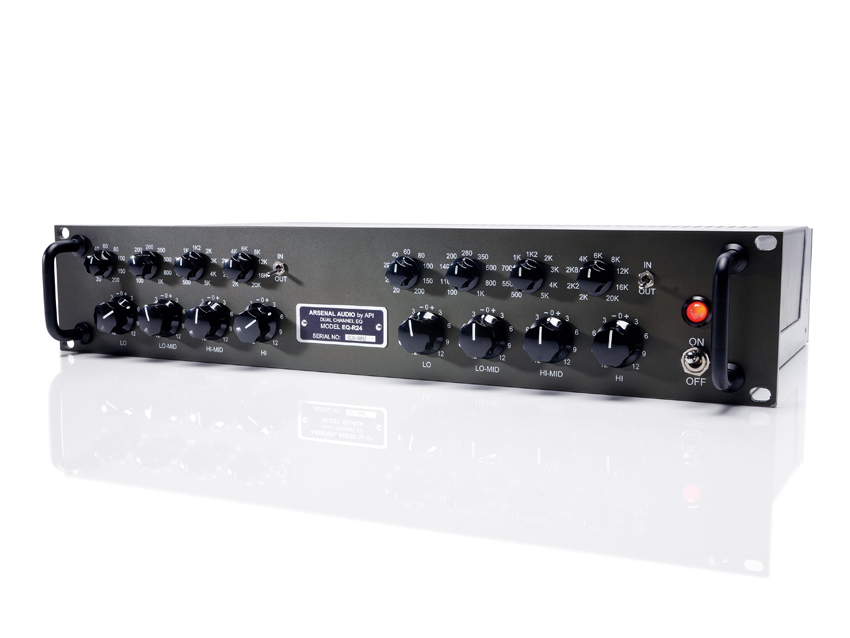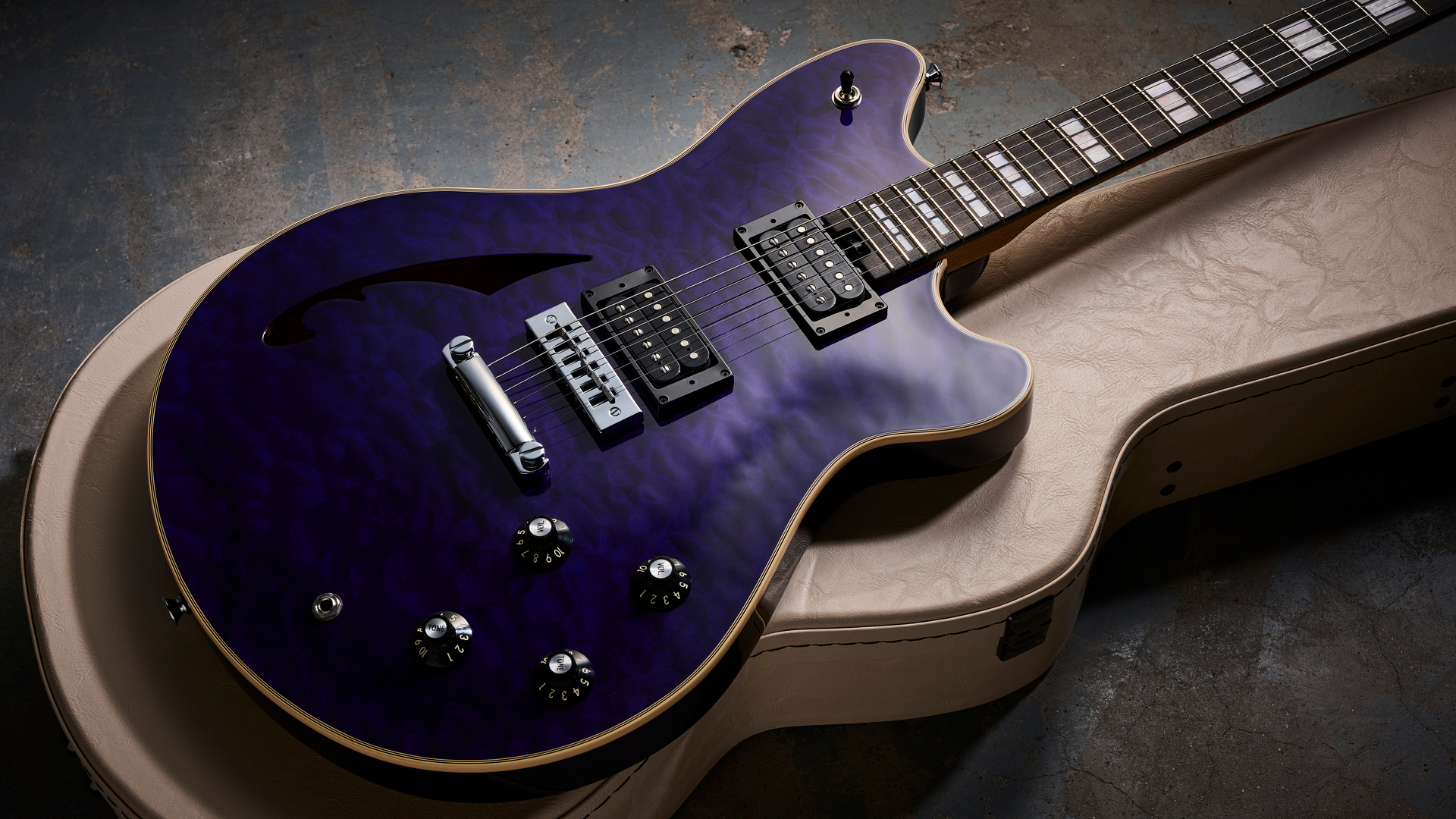MusicRadar Verdict
Simplicity at its best - this is one sweet sounding EQ that audio will adore you for.
Pros
- +
The sound. Clean and transparent tone shaping. Built like a tank (or two).
Cons
- -
£1,000 for an EQ seems steep but then this is an outstanding product
MusicRadar's got your back

Arsenal Audio R24 Dual Channel EQ

Arsenal Audio R24 Dual Channel EQ
According to API company president Larry Droppa, Arsenal Audio has been set up to create products that do not fit into the signature API design parameters. Currently there are three models in the Arsenal Audio fold: the R24 EQ, the V14 EQ (half an R24 in a 500-series frame) and the R20 dual mic preamp.
All three share a military green paint scheme, with the R24 and R20 featuring a 'dog-tag' style product label on the front panel to complete the MASH look. Although the price tag is around the £1,000 mark the R24 is a more cost conscious unit than the API products, especially as it does not feature the legendary API 2520 discrete op amp.
Solid build
The first thing that strikes you about the R24 is the build quality. The military green front plate is a bullet-proof 5mm thick framed with sturdy handles. Having taken the lid off and snooped around the circuit board, it is obvious this is a simple electronic design, something one hopes translates into a clean quality sound.
The EQ ranges for each of the four bands are set through good quality capacitors, with amplification carried out by standard TL072CN op amps. Although these are not the highest-grade option on the market, with a well-designed circuit, they offer plenty of clean gain and bandwidth.
There are two inclusions on the board that are also essential to the performance of the R24. Firstly, each channel has a relay for 'True Bypass' via a front panel 'In/Out' switch. This means that in bypass mode the input is sent directly to the output and so leaves the audio completely unaffected (the unit can be turned on and off without any audible effect on the signal).
Quality transformers
Secondly, there is a transformer on the output of each channel for signal balancing. We are big fans of (quality) transformers on audio outputs as they can provide a more forgiving harmonic distortion (compared to standard op amps) when driven hard.
The two channels of the R24 each feature eight knobs and the EQ In/Out switch. The small upper row of four knobs controls the frequencies for each of the four bands, while the lower four knobs control the 12dB cut/boost. The horizontal offset between the knobs allows plenty of finger room and the value legends are large and clear, making this an easy unit to operate.
The gain control pots are not centre-dented for setting an absolute zero gain value, but in practise this is not an issue due to the bypass switches and the gentle first few dBs of gain. Zero-ing the gain pots is also listed on the factory checklist that is provided in the box.
Sound
With regard to sound, the industry standard adjectives would have to be smooth, transparent and musical. This is every inch the professional quality unit one would expect from API. The wide Q of each frequency band keeps the sound free from unseemly peaking and phase shift artefacts even when two adjacent bands overlap.
The R24 seems to effortlessly bring out the best in any source material, allowing you to quickly enhance signals without introducing harsh overtones or unwanted colouration. Although this unit excels at subtle cuts and boosts, you can easily achieve quite radical tone shaping within the +/- 12dB range without encountering inharmonic distortion.
The mid frequencies are easily pushed and pulled into shape without becoming disjointed and jarring while the high end stays smooth even at high gain settings. We particularly love the way a big boost at 20kHz brings up the life in drum mixes without pushing the cymbals into the back of your head.
As for the low frequencies, well this makes the R24 worth the money alone. Despite the wide Q factor it is simple to zone in on a kick drum or bass guitar and pull it forward without adding unwanted low-mids and therefore having to make a cut further up the range. Four bands of EQ is a luxury considering how much one can achieve with just two of the bands on offer here.
Frequencies
The frequency ranges all overlap by around one octave and each band covers a x10 range (e.g. 100Hz to 1kHz and 2kHz to 20kHz). This not only belies the simplicity of the electronic design used, which is why it sounds so smooth, but it also makes it very easy to use.
With too wide a range assigned to one band it can be difficult to tune an EQ to where it needs to be regardless of the Q width, but the R24 lets you sweep just enough to zone in without requiring micro hand movements.
The circa one octave overlap allows just enough 'hand-over' between EQ bands to allow some close frequency cuts and boosts, but not so much as to make decision-making much of an issue!
When we first opened the box we wondered where the low- and high-shelving switches are that are standard on a four band EQ? While these are highly useful tools, the R24 does not suffer at all from lacking this extra complication. The simplicity, and in particular the fixed Q, only help to keep the signal path clean and free from those nasty phase shifts that can make or break an EQ.
Value for money
Considering the wide bandwidth covered by this unit and the lack of any obvious frequency roll-offs at the extremes I would tend to think that the transformers are also doing a fine job.
Parting with £1,000 for an EQ is no easy decision and one has to consider what this will bring you in the long run. But with the Arsenal Audio R24 this is what one may term a 'no-brainer'.
Firstly, it's built to last, with the only components likely to peg it being the electrolytic capacitors in the power supply, and they've got a good 15 years.
Secondly, the R24 sounds superb and will only improve your quality of work. It sounds just as good as, if not better than, many big name units costing more than twice the price. Let's hope there are more seeds in the Arsenal potting shed.
Future Music is the number one magazine for today's producers. Packed with technique and technology we'll help you make great new music. All-access artist interviews, in-depth gear reviews, essential production tutorials and much more. Every marvellous monthly edition features reliable reviews of the latest and greatest hardware and software technology and techniques, unparalleled advice, in-depth interviews, sensational free samples and so much more to improve the experience and outcome of your music-making.

“From the very start of his social media rise Giacomo has been using other people’s compositions”: Social media guitar influencer Giacomo Turra accused of using other musicians’ arrangements and passing them off as his own

“We finally buried the hatchet!!!”: 20 years after he accused her of miming and called her “a fairground stripper”, Elton John and Madonna are speaking to each other again

“I didn’t think people would mind that I didn’t play it, but it became a problem. I got myself into a pickle”: Clairo says it was Charli XCX who convinced her to perform one of her most popular songs again










